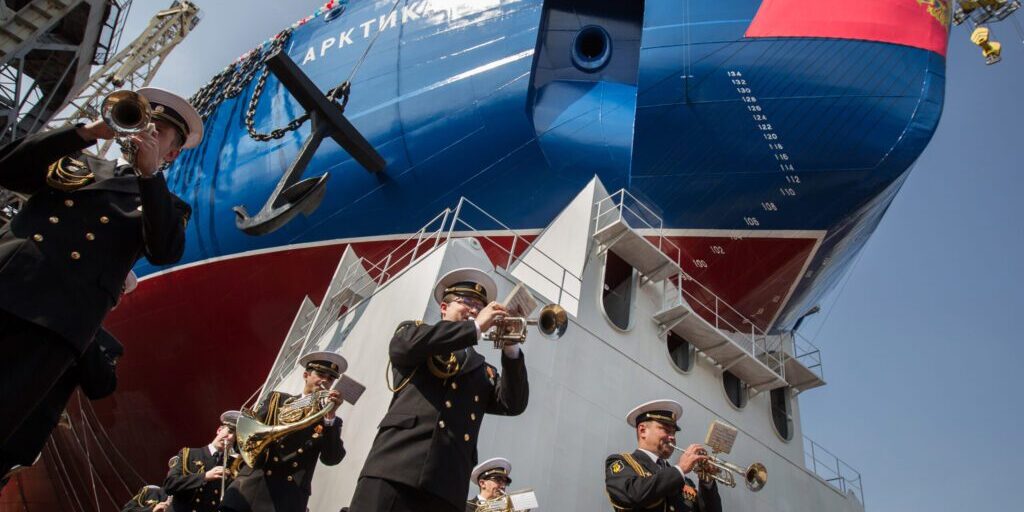Nome, Alaska — Activity in the Arctic is on the rise.
Retreating sea ice and rising ship traffic have some worried the region could serve as the next stage for international conflict, but coast guards across the Arctic are busy laying the groundwork for cooperation.
Russia just launched the largest, most powerful icebreaker in the world.
Blue and red balloons fly through the air as onlookers cheer from the docks at St. Petersburg shipyard. It’s a massive vessel, bright blue with the Russian flag painted front and center on the bow of the boat.
The icebreaker is the first in a series of ships the nation plans to launch in the coming years, and that worries many, since Russia’s icebreaker fleet is larger than every other Arctic nation combined.
But Andreas Østhagen said that isn’t foreshowing an Arctic-style arms race.
“I don’t think it’s all about counting icebreakers, as some tend to do in the Arctic,” Østhagen said.
Østhagen works for the Norwegian Institute for Defense Studies in Oslo. According to Østhagen, what’s more important is how the captains of those icebreakers cooperate.
In an article recently published in the Arctic Review on Law and Politics, Østhagen argues coast guards are the key to keeping the peace in the far north.
“All the Arctic coast guards have different institutional setups,” Østhagen explained. “They have different capabilities, or lack of capabilities, so I think sharing information and sharing best practices is key.”
They’ve been doing just that through the Arctic Coast Guard Forum, established last fall. Leaders representing the coast guards of all eight Arctic nations gathered again in Boston recently to sign a multi-year strategic plan for the Arctic.
That joint agreement joins an increasingly lengthy list of international accords for the region. Namely, the Arctic Search and Rescue Agreement, adopted in 2011, and the Agreement on Cooperation on Marine Oil Pollution, Preparedness and Response in the Arctic, adopted in 2013.
Ultimately, Østhagen said, the severe weather and remoteness of the region necessitates cooperation between coast guards.
“If an incident were to occur, let’s say an oil spill actually took place in the Arctic or a cruise ship were to go down in the Northwest Passage or around Greenland or in the Bering Sea or Barents Sea, then everyone would have the interest of trying to save these people, trying to minimize damage,” Østhagen said.
An incident did occur in 2014 when a Korean fishing vessel went down in the Bering Sea.
At the Glacier Conference in Anchorage last fall, Rear Admiral Dan Abel said the Coast Guard was in constant communication with Russian search and rescue efforts.
“We were posting messages, we were synchronizing their response, we were synchronizing what South Korea was sending,” Abel said, “and at the tactical level, things were working extremely well.”
While nearly everyone aboard the vessel died at sea, Abel said both the US and Russia shared the same objective.
“When it comes to saving lives and protecting the environment, those are kind of universally accepted goods that both countries realize should be beyond any geopolitical interests.”
Those geopolitics interests have come to a head recent years, with Russia’s annexation of Crimea and resulting international sanctions.
Because of that and lingering Cold War tensions, Abel said he’s not completely carefree when he sends the Healy, one of only two American icebreakers, into the Arctic.
“There is no buddy system for her,” Abel explained. “If she dings a prop [or] she has some problem with a reduction gear, there’s nothing with an American flag that’s going to come save her.”
Abel said it’s those solo voyages in the Arctic that keep him up at night.
“If you extend that far into some very hostile area, she’s a lone vessel out there, and we certainly wish her a safe voyage, get her work done, and get her home.”
The Healy just set sail for its first solo trip in the Arctic this season. It’s not as strong or shiny as Russia’s newest icebreaker, but with less emphasis on military operations and more on research, for now, it doesn’t have to be.







